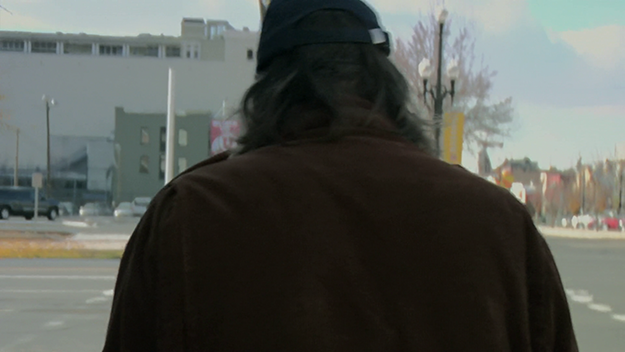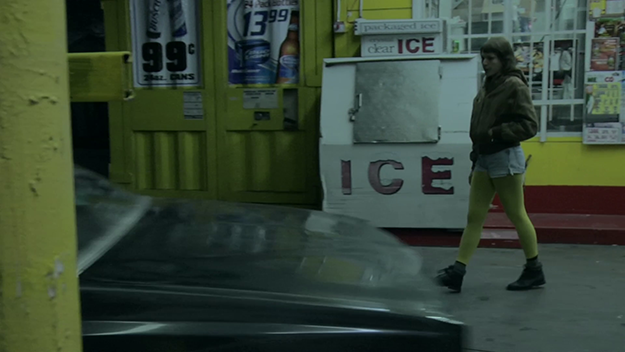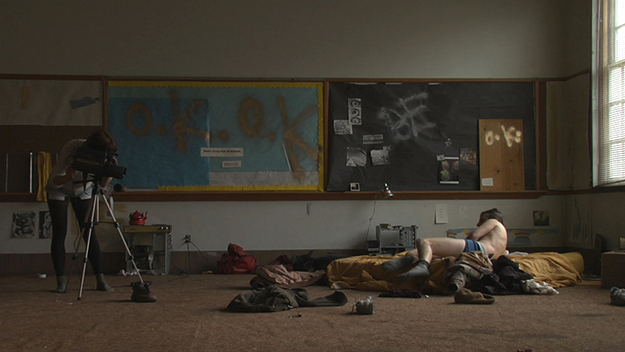Notebook: Bad Fever
“Local Color: The Short Films of Dustin Guy Defa” opens today at the Film Society of Lincoln Center, with the director in person on October 14 and 16. Below is Leah Churner’s appreciation of Defa’s debut feature Bad Fever.

When we first meet Eddie Coopersmith, the extraordinary protagonist of writer-director Dustin Defa’s first feature Bad Fever, the camera follows him from behind: a tall frame in a huddled posture, head down, matted long hair, baseball cap, hurrying into a gas station mini-mart. Then we watch the tail lights of his sinister black car, driving slowly, braking often, exhaust billowing into the cold. When we see his face, it is through the dingy windshield, peering at female pedestrians over a pile of stuffed animals on his dashboard. He looks creepy at best, dangerous at worst. This is how the world sees him. In his own mind, he is a successful standup comedian. He begins a mumbling monologue in the driver’s seat, trying to write his act, and returns to it throughout the film: “Let me start off by saying my name is Eddie Coopersmith. You all know me very well. Let me start off by saying that I will say a little about my day.”
Like Rupert Pupkin in Martin Scorsese’s King of Comedy, Eddie walks around imagining an appreciative audience of invisible fans. But unlike Robert De Niro’s charismatic, daring New York hustler, Eddie, played by Kentucker Audley, is a pathologically shy resident of Salt Lake City, where there is neither a beckoning skyline nor celebrities in tantalizing geographic proximity. Bad Fever does not build to an absurdist media circus, much less take “celebrity” as its subject. It’s a small-scale, painfully candid examination of the connection between loneliness and creativity: is art made in a vacuum valid at all? Can it be cathartic without the receptive praise of other people? For Eddie’s sake, we’d like to hope so, but the film persists in probing the question.
Defa, a Salt Lake City native who now lives in Brooklyn, made a strong impression at Sundance, SXSW, and True/False last year with his experimental documentary short Family Nightmare, in which he condensed over 40 hours of his family’s VHS home video footage into a 10-minute shard of personal hell, manipulating the speed of the audio and replacing most of the voices on the soundtrack with his own mimickry. Defa has a talent for making “clean” images disturbing: without explicitly depicting either, Nightmare hints at a family history of violence and addiction. It is a visceral immersion in Defa’s bad memories, made all the more disturbing (and darkly compelling) for being an objective record, rather than a subjective recollection, of events. The visual properties of old, degraded VHS—a surreal blurring of faces and bleeding of motion inherent to low-resolution video—heighten the malaise and foreboding.

Bad Fever was mostly shot in HD, but Nightmare’s muddy analog-video aesthetic, along with actual VHS footage, figures into the story. So does the theme of self-recording and re-recording. Eddie acquires a tape recorder and ambles around dredging the linguistic sludge of his brainpan for jokes, which he drains into the microphone. (“I want to jump around on a trampoline that… it’s just a trampoline, you jump on it and that’s the end of the transaction.”) At home, where Eddie lives with his mother, he plays the tapes back for himself. Like the protagonist of Robert Bresson’s Four Nights of a Dreamer, Eddie’s compulsion to record himself seems motivated less by narcissism than plain loneliness: his own voice as a substitute for human company. Eddie lobs painful questions into the void: “Does anybody even want to know what I do with my day? Does anybody even want to know about my lifestyle? Does anybody want to even know that my life might not be as great as you think it is?”
Outside the gas station, Eddie meets Irene (Eleonore Hendricks), who is standing around shivering and asking strangers to buy her a pack of cigarettes. Eddie complies, and takes her to a restaurant. Unsure just what sort of weird john she’s dealing with, Irene reveals that she squats in an abandoned elementary school and earns money by mailing videotapes of herself to Larry, a man she met on the Internet. She claims not to do anything sexual in the videos, and Eddie believes her, even after she turns the camera on him and directs him to strip. He refuses, flees, and incorporates his ambivalence about Irene’s not-very-romantic ways into his ongoing monologue. Eddie comes back, though, showing up unannounced at her hovel on a regular basis, and she continues to pressure him into amateur-porn scenarios for the camera. He pretends to take a bath in his underwear, and simulates sex with a mop. (Eddie is such a clumsy, inept, unsexy S&M star that the effect is hilarious.) Meanwhile, he attempts an old-fashioned courtship, dressing up in a powder-blue suit and taking her on a date to a petting zoo. (“This is a very significant farm in my life,” he explains.)
Eddie then arranges the night of his dreams. After demanding a Friday-night slot from the proprietor of the comedy club, he invites Irene over to meet his mother (Annette Wright), a glowering, sedentary bump-on-a-log. He worsens the tense silence by babbling about the snacks he’s laid out. (“These are almost my favorite type of cracker. Mom, remember when I used to eat this and other kinds of crackers?”) En route to his stage debut, with Irene in the front seat and Mom in the back, Eddie ventures more and more out of his shell, to Irene’s growing mortification. Later, Eddie and Irene go to a motel; having never been in bed with anybody, he cluelessly inquires how much time she would like him to program into the sleep timer on the TV remote control.

Irene is any comic’s worst nightmare, the “tough crowd” personified. Yet she is sympathetic too, because her jaded loneliness may be worse than Eddie’s innocent kind. While he pines for the attention of others, she is alienated by his indiscriminate idealization, and even more by Larry’s. Neither man wants to get to know her, only to project upon her an already worshiped feminine ideal. (Intriguingly, Defa casts himself in the Larry role: the director as exploiter behind the scenes.)
Written, according to the director, during a bad bout of fever, and partially re-written by Audley, the film floats in a surreal haze; if this were someone else’s movie, Eddie would be played by a Philip Seymour Hoffman type rather than the handsome Audley, and Irene wouldn’t be lugging around a gigantic, obsolete 1980s camcorder. The soundtrack is left to reflect the dreamlike effect through a device Defa uses: each time we expect a musical cue, the sound of a howling wind rears up. It’s a little too minimalistic for my tastes; Audley’s poignantly vulnerable performance would’ve been better reinforced by a single perfect pop song at the climactic moment, Fassbinder-style, to counter the starkness with a little romantic glue. Still, at 72 minutes, the film has a deft narrative economy; even with the use of voiceover, Bad Fever shows more than it tells. Ultimately, Eddie is funny, because, like any comedian, he induces our shock of recognition.







